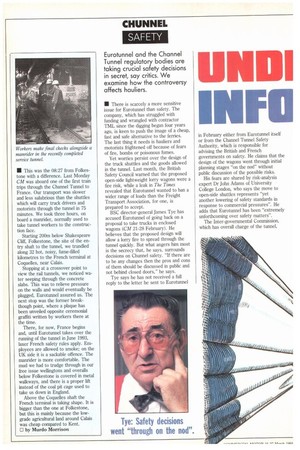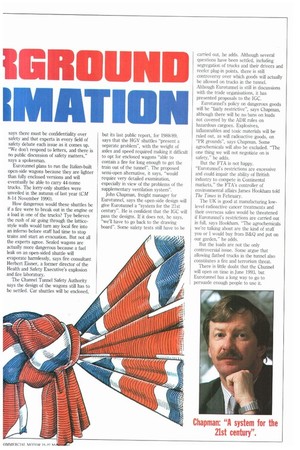• This was the 08:27 from Folkestone with a difference.
Page 48

Page 49

If you've noticed an error in this article please click here to report it so we can fix it.
Last Monday CM was aboard one of the first train trips through the Channel Tunnel to France. Our transport was slower and less salubrious than the shuttles which will carry truck drivers and motorists through the tunnel in 75 minutes. We took three hours, on board a manrider, normally used to take tunnel workers to the construction face.
Starting 200m below Shakespeare Cliff, Folkestone, the site of the entry shaft to the tunnel, we trundled along 32 hot, noisy, fume-filled kilometres to the French terminal at CoqueIles, near Calais.
Stopping at a crossover point to view the rail tunnels, we noticed water seeping through the concrete slabs. This was to relieve pressure on the walls and would eventually be plugged, Eurotunnel assured us. The next stop was the former breakthough point, where a plaque has been unveiled opposite ceremonial graffiti written by workers there at the time.
There, for now, France begins and, until Eurotunnel takes over the running of the tunnel in June 1993, laxer French safety rules apply. Employees are allowed to smoke; on the UK side it is a sackable offence. The manrider is more comfortable. The mud we had to trudge through in our free issue wellingtons and overalls below Folkestone is covered in metal walkways, and there is a proper lift instead of the coal pit cage used to take us down in England.
Above the Coquelles shaft the French terminal is taking shape. It is bigger than the one at Folkestone, but this is mainly because the lowgrade agricultural land around Calais was cheap compared to Kent. 0 by Murdo Morrison • There is scarcely a more sensitive issue for Eurotunnel than safety. The company, which has struggled with funding and wrangled with contractor TML since the digging began four years ago, is keen to push the image of a cheap, fast and safe alternative to the ferries. The last thing it needs is hauliers and motorists frightened off because of fears of fire, bombs or poisonous fumes.
Yet worries persist over the design of the truck shuttles and the goods allowed in the tunnel. Last month, the British Safety Council warned that the proposed open-side lightweight lorry wagons were a fire risk, while a leak in The Times revealed that Eurotunnel wanted to ban a wider range of loads than the Freight Transport Association, for one, is prepared to accept.
BSC director-general James Tye has accused Eurotunnel of going back on a proposal to take trucks in enclosed wagons (CM 21-28 February). He believes that the proposed design will allow a lorry fire to spread through the tunnel quickly. But what angers him most is the secrecy that, he says, surrounds decisions on Chtmnel safety. "If there are to be any changes then the pros and cons of them should be discussed in public and not behind closed doors," he says.
Tye says he has not received a full reply to the letter he sent to Eurotunnel in February either from Eurotunnel itself or from the Channel Tunnel Safety Authority, which is responsible for advising the British and French governments on safety. He claims that the design of the wagons went through initial planning stages "on the nod" without public discussion of the possible risks.
His fears are shared by risk-analysis expert Dr John Adams of University College London, who says the move to open-side shuttles represents "yet another lowering of safety standards in response to commercial pressures". He adds that Eurotunnel has been "extremely unforthcoming over safety matters".
The Inter-governmental Commission, which has overall charge of the tunnel, says there must be confidentiality over safety and that experts in every field of safety debate each issue as it comes up. "We don't respond to letters, and there is no public discussion of safety matters," says a spokesman.
Eurotunnel plans to run the Italian-built open-side wagons because they are lighter than fully enclosed versions and will eventually be able to carry 44-tonne trucks. The lorry-only shuttles were unveiled in the autumn of Last year (CM 8-14 November 1990).
How dangerous would these shuttles be if a fire were to break out in the engine or a load in one of the trucks? Tye believes the rush of air going through the latticestyle walls would turn any local fire into an inferno before staff had time to stop trains and start an evacuation. But not all the experts agree. Sealed wagons are actually more dangerous because a fuel leak on an open-sided shuttle will evaporate harmlessly, says fire consultant Herbert Eisner, a former director of the Health and Safety Executive's explosion and fire laboratory.
The Channel Tunnel Safety Authority says the design of the wagons still has to be settled. Car shuttles will be enclosed, but its last public report, for 1988/89, says that the HGV shuttles "present a separate problem", with the weight of axles and speed required making it difficult to opt for enclosed wagons "able to contain a fire for long enough to get the train out of the tunnel". The proposed semi-open alternative, it says, "would require very detailed examination, especially in view of the problems of the supplementary ventilation system".
John Chapman, freight manager for Eurotunnel, says the open-side design will give Eurotunnel a "system for the 21st century". He is confident that the IGC will pass the designs. If it does not, he says, "we'll have to go back to the drawing board". Some safety tests still have to be carried out, he adds. Although several questions have been settled, including segregation of trucks and their drivers and reefer plug-in points, there is still controversy over which goods will actually be allowed on trucks in the tunnel. Although Eurotunnel is still in discussions with the trade organisations, it has presented proposals to the IGC.
Eurotunnel's policy on dangerous goods will be "fairly restrictive", says Chapman, although there will be no bans on loads not covered by the ADR rules on hazardous cargoes. Explosives, inflammables and toxic materials will be ruled out, as will radioactive goods, on "PR grounds", says Chapman. Some agrochemicals will also be excluded. "The one thing we will not negotiate on is safety," he adds.
But the FTA is not happy.
"Eurotunnel's restrictions are excessive and could impair the ability of British industry to compete in Continental markets," the FTA's controller of environmental affairs James Hookham told The Times in February.
The UK is good at manufacturing lowlevel radioactive cancer treatments and their overseas sales would be threatened if Eurotunnel's restrictions are carried out in full, says Hookham. "The agrochemicals we're talking about are the kind of stuff you or I would buy from B&C) and put on our garden," he adds.
But the loads are not the only controversial issue. Some argue that allowing flatbed trucks in the tunnel also constitutes a fire and terrorism threat.
There is little doubt that the Chunnel will open on time in June 1993, but Eurotunnel has a long way to go to persuade enough people to use it.
























































































